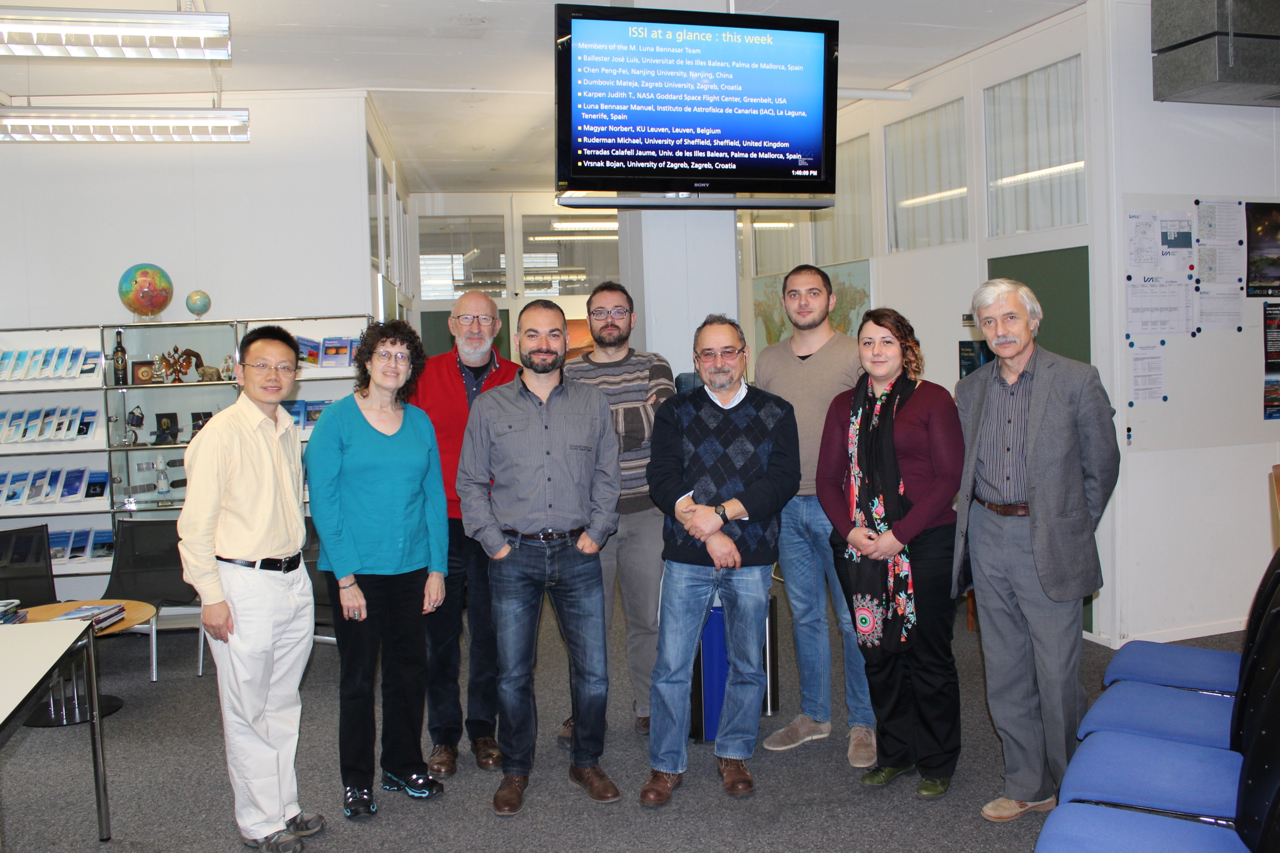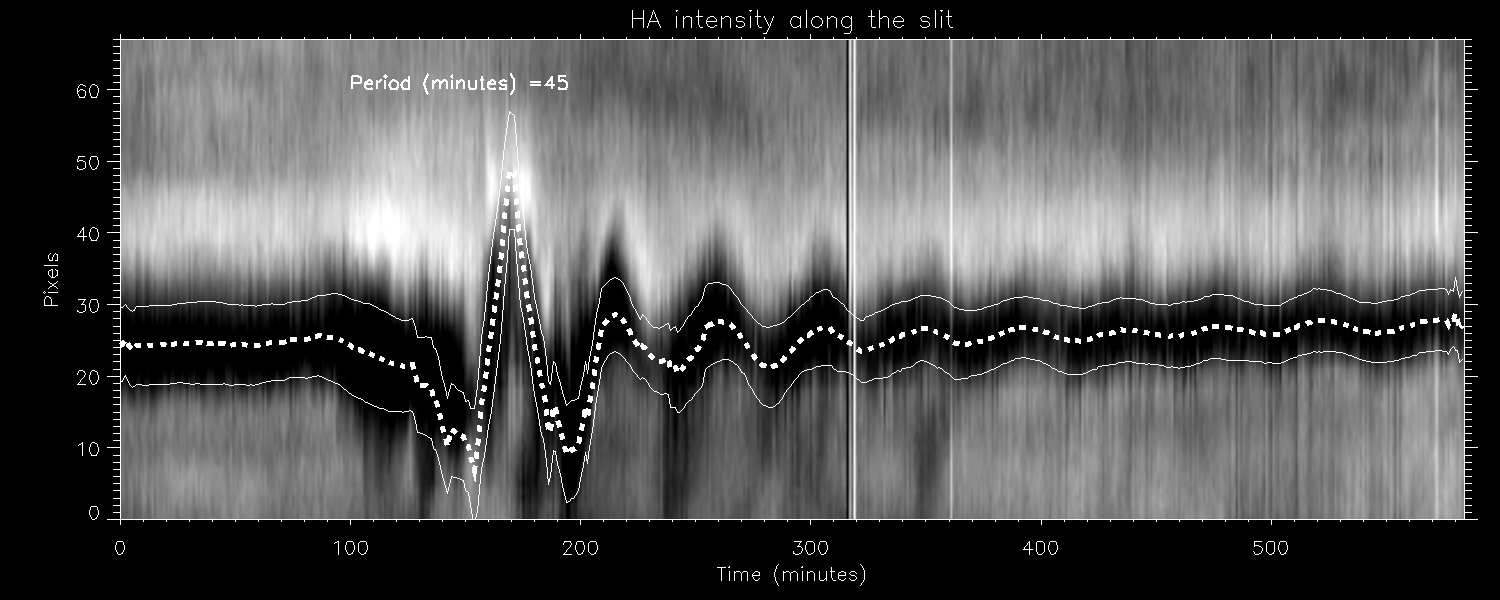2nd Meeting:
Links:
GONG Hα data (click): Here you can find GONG data. Select the telescope of the network, the initial and end time, etc.
Catalog of EUV coronal waves: http://aia.lmsal.com/AIA_Waves/index.html
Pictures:
 To do list:
To do list:
Some of the following points come from the previous meeting (in red). Some of the following points are in progress. We are focussed in point 2 of observations trying to make a GONG catalogue of LAOs (see below for few comments on it)
Observations:
- Make a catalogue with the data already published and try to find regularities.
- Make a catalogue directly looking at the available data. It is necessary to define a strategy for this point. The LALO are easily detectable in ha but the LATOs maybe not.
- Try to determine the possible coupling between the longitudinal and transverse motions. Also try to find transverse oscillations.
- Study some good examples from different points of view. COMMENTS: Mateja said the 2011 is a good year to observe with STEREO because they are in quadrature.
- Study photosphere and try to find signatures of the LAOs and triggering. COMMENTS: MAYBE it is not possible because even in large flares there are no clear signatures on magnetograms. The observations on flares the initial and final magnetic configurations (magnetograms) are different. PETER and JAUME
- Try to find an oscillatory event where the filament is located at the limb and where the field lines can be seen. MANUEL, PENG-FEI also combine with STEREO.
- Try to find asymmetric oscillation in the sense that the oscillations are along non-uniform radius curvature.
- Study the triggering agents/events and the LAOs events. MATEJA, JUDY, MANUEL
- Study the event of 2015-03-15 and make seismological reconstruction of the magnetic field. Also Tilaye is going to make the NLFFFE. MANUEL, ALL
Theory:
- Study the excitation of longitudinal oscillations by transverse oscillations: nonlinear excitation (pondemorotive). JAUME, JOSÉ LUIS, MICHAEL
- Study the longitudinal oscillations in non-uniform curvature dips. Also include torsion. MICHAEL, MANUEL and JUDY. MICHAEL proposes to make a 3D reconstruction of the field lines combining two perspectives of the oscillations.
- Study the triggering of LAOs by simulations. It can be also done analytically. There are analytic profiles to put the initial coronal wave. The destabilization of primary filament could produce the first fast wave and the second EIT perturbation associated to changes of the magnetic field configuration. PENG-FEI, JAUME, JUDY, MANUEL
- Resonant absorption in transverse oscillations. COMMENT: Jaume has studied this problem and found resonant absorption in 3D. Is it possible to find an analytic solution of this problem? Maybe it is more easy to make a parametric study of the parameters for seismology.
- Shift of frequency related to the large amplitude. Also numerical. Shift of frequency proportional to the amplitude squared. The damping is also dependent on the amplitude.
- Analytical study of longitudinal oscillations including non-adiabatic effects in 1D model. JOSÉ LUIS, MANUEL
- Extent to longitudinal oscillations on loops to filaments. In loops the conduction is important but in filaments it is not important. It necessary to modify the model.
- Include mass change in a wave model.
- Study the stability on prominences. Check literature. Bojan points that checking the frequency of helical filaments we can determine the instability of the filament. High freq. -> stable and low freq. -> less stable maybe approaching to instability.
- Numerical simulations of jets in filament channel structures.
- Numerical simulations of an eruption producing oscillations in another filament. See February 24.
- Also simulations of an external wave (shock) producing oscillations on filament.
GONG Catalogue
Task for the team members:
Two months should be analyzed by each team members. One corresponds to the solar minima 2010 and one corresponds to solar maxima.
Go to the GONG data and visualize day by day with an Image Increment of 5 (minutes).
José Luis: Jan. 2014 Jan. 2011
Peng-Fei: Feb. 2014 Feb. 2011
Judy: Mar. 2014 Mar. 2011
Manuel: Apr. 2014 Apr. 2011
Jaume: May. 2014 May. 2011
Bojan: Jun. 2014 Jun. 2011
Mateja: Jul. 2014 Jul. 2011
Norbert: Aug. 2014 Aug. 2010
Jasa: Sep. 2014 Sep. 2010
Holly: Oct. 2014 Oct. 2010
Pete: Nov. 2014 Nov. 2010
Qingmin: Dec. 2014 Dec. 2010
I have been working trying to fit the oscillations from the data taken from the slits. This is not trivial because the idea is to obtain the oscillatory parameters automatically. In the following to can find one example:
I have fitted a Gaussian for the intensity at each time. The dashed thick line corresponds to the center of the Gaussian and both thin lines correspond to the width of the Gaussian fit. It seems nice but it has problems. For example at the beginning of the oscillation the dark band is not well fitted. It is also interesting to see that the oscillation remains for a long time.

